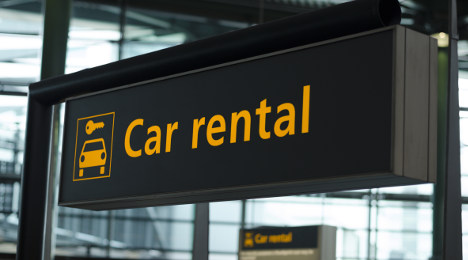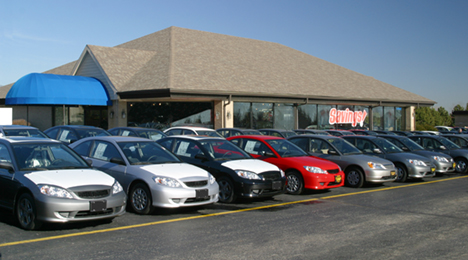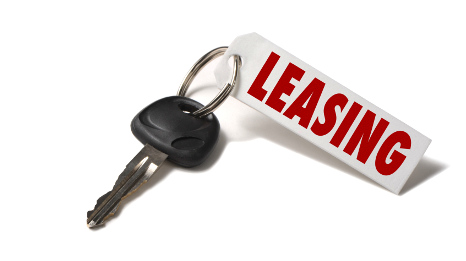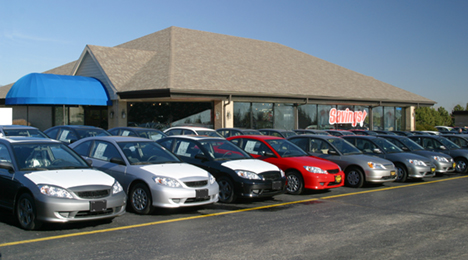Chances are, dealers at auction looking to shore up their supply of 1-year-old vehicles will find a good bit of vehicles from the rental-heavy segments.
That’s according to the latest issue of Guidelines from NADA Used Car Guide, which said that off-rental units are currently making up a large portion of 2013 model-year auction volume.
That being the case, the report says, “rental-heavy” segments like compact utility vehicles, compact cars, midsize cars, midsize utility vehicles and midsize vans are the auction volume leaders for this age group of vehicles.
“When concentrating on models within these segments where auction volume was greatest, depreciation tended to be most severe for Ford vehicles last month,” NADA’s Jonathan Banks said in the report.
On the new-car side, NADA cited WardsAuto data indicating that days’ supply was at 60 last month, down from 69 in April but up from 58 in May 2013.
“Supply levels have been on average three days higher than year-ago levels from March to May, down dramatically from the 12 day average of the first two months of the year,” Banks said in the report.
Although the average age of a vehicle on the road today is steady from a year ago and appears to have reached a “plateau,” the number of vehicles out there has hit an all-time, according to IHS Automotive.
And in what’s potentially good news for dealers and their certified pre-owned operations, IHS is forecasting strong volume gains in the next five years for vehicles ages zero to 5 years old.
Overall, IHS said — citing its July 2013 analysis — that there were more than 252.7 million total light vehicles in operation, which is an all-time high and a 1.5-percent year-over-year rise (or, put differently, a 3.7 million-unit increase).
When asked what the impact this record number of VIO will have for dealers in the used-car market, Mark Seng, director, aftermarket solutions and global aftermarket practice leader at IHS Automotive, shared this: “Record VIO in general is good for used-car market availability. Too much supply, of course, may drive prices down, but the fact that new registration demand seems to be driven more by replacement demand rather than ‘false’ demand of a booming economy, it may keep the excess demand in check to a point.”
Given how strong the U.S. auto market has bounced back, thus leading to increases in new-vehicle registrations, IHS projects a 32-percent rise in volume over the next five years for vehicles ages zero to 5, but a 21-percent slide in the number of 6- to 11-year-old units.
Looking at the projected VIO growth for the 5-year-old and younger class, there are certainly benefits dealers could see within their CPO operations.
“With new registrations growing again and new- to 5-year-old vehicles on the rise, this certainly offers the dealers a growing warranty customer base again and the potential to create relationships with these car owners in order to try and get them to remain dealer customers as their vehicles age, rather than going to the independent aftermarket, which is what typically happens when the vehicle is no longer under warranty,” Seng noted.
As for vehicles 12 years or older, IHS says this population will remain on the upward track and jump 15 percent in the next five years, given improved vehicle quality and longer ownership periods.
As of Jan. 1, the average age of a vehicle on U.S. roads today was 11.4 years, which is even with prior numbers, IHS said. Next year will likely bare the same results, before the average age increases to 11.5 years by 2017 and then 11.7 years by 2019. Thanks to much stronger new-car sales, this projected growth rate over the next five years is less than the clip from the prior period, IHS said.
“In our history of tracking, we have seen a gradual increase in the average age of vehicles on the road,” said Seng. “This year, we’re seeing somewhat of a plateau in the market, and expect it to remain over the next few years, without a major change in either direction.
“We attribute this to a number of factors, including the economy and the increasing quality of today’s automobiles.”
IHS noted in its report that new-car registrations beat scrappage by over 24 percent, which hasn’t happened in a decade.
In 2013, there were 11.5 million units scrapped, which IHS said was “significantly fewer” than numbers from prior years — like, for instance, the all-time high of 14 million scrapped in 2012.
“This while VIO is up 1.5 percent, a rate the auto industry hasn’t seen in the U.S. since 2004-2005,” IHS would add.
At the recent Stephens Spring Investment Conference, the leadership of KAR Auction Services spoke on the expected influx of off-lease vehicles and how this trend will impact the company's businesses, as well as where these off-lease vehicles will end up in the remarketing process.
The Wall Street Webcasting website provided a webcast of their presentation made by KAR chief executive officer Jim Hallet and chief financial officer Eric Loughmiller, at the New York event.
Management explained they are keeping an eye out on trends regarding where off-lease vehicles will be heading in the remarketing sales “funnel,” as Loughmiller put it.
Questions such as these are becoming increasingly important as the industry prepares for considerable growth in available off-lease inventory — and an overall recovery in the used-car business.
“We are in the early stages of a cyclical recovery in the used-car business, it is heavily driven by the events of a few years ago. It started several years ago, when we ended up with some interruption in the financial and used-vehicle space, which all trickled through, and now we are actually coming off of the bottom where SAAR is growing, leasing is growing, and repossessions are looking like they are growing because of subprime lending,” Loughmiller said, opening the presentation.
What is primarily driving this cyclical recovery in the pre-owned business? Growth in the amount of available off-lease cars, says Hallett.
“In 2008 and 2009, leasing came to a standstill, and consumer credit froze. And the two big drivers of our business is off-lease returns and repossessions. So what happened is we ran those portfolios off … but then leasing got rebooted in 2010 and consumer credit started to loosen up, so what we are seeing is the third anniversary of leases that were written in 2010,” Hallett explained, going through the company’s experience during the recent economic downturn.
The two executives said the industry expects to see an additional 300,000 off-lease vehicles return to the market this year, with that number expecting to increase by another 700,000 vehicles in 2015.
Add another incremental 500,000 vehicles to the mix, expected to hit in 2016 — “and you can see we have got some pretty heavy tailwinds behind us here,” said Hallett.
The company’s volume was up 7 percent in Q1, management pointed out, growth that was primarily driven by off-lease returns.
Hallett said the company expects its volumes to increase throughout the rest of this year, as well.
Where KAR’s Off-Lease Vehicles Are Headed
And as these off-lease vehicles enter the remarketing stream, they have a variety of places they could end up in the KAR pipeline.
The first stop in the sales “funnel,” as company management coined the remarketing process for these vehicles, is its OPENLANE private label sites for automakers.
Loughmiller explained, “Of all the off-lease vehicles that come onto the market, 90 percent of those private label sites are coming to us to sell them.
“We get the first opportunity at the car,” he said.
Not surprisingly, as inventory began expanding last year for the first time since before the 2008 recession, franchised dealers were eager to expand their inventory, buying up the majority of off-lease vehicles before they made it off the automaker’s closed sale sites.
Dealers are also becoming more and more comfortable purchasing vehicles online — in the first quarter, 37 percent of KAR’s vehicles were sold online; in 2009, that number came in at about 18 percent.
“Dealers have been starved for inventory through 2011 and 2012. We really hit that trough, and when these cars are coming into the funnel again, dealers were aggressively buying these care and continue to do so, with some focused on getting dedicated used-car lots. We think that pace is going to slow down, and ultimately help our economics and continue to grow the business,” Hallett said.
If the off-lease vehicles aren’t sold at the closed online sales, they will then trickle down to open online sales, and ultimately, end up at the physical auction — where the vehicles will make significantly more revenue for KAR.
“When the vehicles make it to the physical auction, we have the opportunity to increase our revenues by providing ancillary services. We operate reconditioning shops, paint and body shops, mechanical shops — we do a number of services which drives our revenue,” said Hallett.
Loughmiller chimed in, noting, “I think what our investors are betting for and management is we are hoping more of these cars make it to the physical auction."
“We feel like these franchised dealers can only absorb so many of these cars,” he added, at which point in time these vehicles will be passing further through the sales funnel.
“We are expecting that in the second quarter, more and more of these cars will get to a physical auction,” Loughmiller said.
Another reason franchised dealers might back off from purchasing so many of these vehicles on the closed sale sites in the coming months has to do with the industry returning to some of the “bad habits” that spurned the leasing shut down in 2008 and 2009.
“When leasing stopped and got restarted, one of these things that got these leasing companies in a bad way is they were setting their residuals too high … and many consumers were upside down on these cars when they went to return them,” explained Loughmiller. “When they got back into the game, they right-sized residuals. But those residuals have crept back up again to where those cars aren’t that attractive to dealers when they first come back, so we think the franchises will pass to buy them on a lower residual in open sale.”
When asked whether it will be a regional shift, Hallett said he thinks these vehicles will move farther down the sales pipeline on a national scale.
“I don’t think it is a regional thing. I think it is more of a national scale, we have contracts in place with almost every one of the manufacturers. We have greater market share depending on the customer and market, but as we go into the funnel, it is a question of demand,” he concluded.
The percent of people coming in with trade-ins is down from its peak level, says Edmunds.com senior analyst Jessica Caldwell, but this might actually be a good sign.
In a conference call to discuss May auto sales, Caldwell said this trend likely points to “people adding to their fleets rather than just replacing.”
The average age on trade-ins, Caldwell also said during the call, is over six years.
Tuesday’s call also covered some of the impact from the General Motors recalls. Based on the latest monthly sales results, the attention doesn’t seem to be hurting GM.
The automaker reported Tuesday that the 284,694 cars it sold in the U.S. last month marked its strongest May since 2007 and its best month (May or otherwise) since August 2008.
“The momentum we generated in April carried into May, with all four brands performing well in a growing economy and 17 vehicle lines posting double-digit retail sales increases or better,” said Kurt McNeil, U.S. vice president of sales operations.
In a bit of analysis sent out prior to the call, Caldwell said: “Despite the overwhelming amount of attention placed on the GM recalls in May, car shoppers don't seem to be holding anything against GM brands.
“Shopper consideration for every GM brand has remained consistent through the recall headlines. Many people may not realize that GM is the parent company of these brands, but others may be overlooking the trouble with older models and simply seeking shiny new sheet metal that serves their needs,” she added.
As their used-car operations churn out stronger numbers, both franchised and independent dealers have been more willing to shell out extra money for the cars their customers bring to the lots, according to CNW Research.
In fact, when considering all 16 vehicle segments included in CNW’s data set, franchised dealers offered a weighted average of $10,406 in 2013 for trade-ins from customers shopping for new vehilces and $6,257 for trade-ins from customers looking to buy used, the firm said in its latest Retail Automotive Summary.
Those represent gains of 12.61 percent and 4.79 percent, respectively, from 2011.
As for independents, the weighted average of what they offered on trade-ins during used transactions last year was up 25.07 percent from 2011 at $3,707.
“While the comparisons are skewed because of the recession, the growth in used-car sales has spurred a boom in what they offer for trade-ins,” CNW president Art Spinella said in the analysis.
He would later re-iterate: “As pointed out, the comparison to 2011 is somewhat misleading because dealers were just coming out of the automotive recession and had more than enough consumer enthusiasm and volume to allow them to offer lower prices on trades.
“In some cases, the difference between 2011 and 2005 was as much as 40 percent lower,” Spinella continued. “That said, trade-in prices last year and the opening quarter of 2014 when including incentives are up substantially.”
Given the broad range of pricing and the varying degrees of change that exist among the 16 segments included in the set, it may also be useful to look at individual vehicle categories.
For franchised dealers taking in trades from new-car shoppers last year, the greatest increase (percentage-wise) in amount offered was within the compact pickup segment (up 39.9 percent from 2011), followed by the budget car segment (up 31.81 percent). Five other segments were up double-digit percentages and nine were up single-digit percentages.
Meanwhile, when franchised dealers were taking in trades from used-car shoppers in 2013, the amount offered increased by double-digit percentages on all but two segments (compacts, up 7.32 percent from 2011; near luxury, up 7.03 percent from 2011). The biggest jump from 2011 was for minivans, which were fetching 57.92 percent more as trade-ins. Lower-middle vehicles (up 56.97 percent) and budget vehicles (up 49.84 percent) weren’t far behind.
Independents, on the other hand, upped the amount offered to used buyers on trade-ins by double-digit percentages on all 16 vehicle segments.
The most significant increase between 2011 and 2013 was for the full-size pickup segment, whose trade-in offers were up 38.84 percent.
Offering additional context, Spinella said: “While the trade-in prices may seem low in general terms, note that dealers are confronted with many older vehicles that have long seen their prime. Many are slated for the wrecking yard or auction but will never go on the franchised dealer’s lot.”
April’s retail supply trends followed March closely, as the demand for sportier cars continues to spike as summer nears.
That’s according to April’s installment of vehicle scarcity data that is provided monthly to Auto Remarketing from AutoTrader.com.
Much like in March, sporty cars continued to show scarcity across the nation during April.
The CPO BMW M Series took the No. 1 spot on the national certified pre-owned scarcity list, and the used Audi A6 took the No. 1 spot on the late-model used scarcity list.
Interestingly, neither of these vehicles were on those respective scarcity lists in the previous month.
On the other hand, many models that showed up on the lists in March continued to prove difficult to find in April, such as the Volkswagen Golf R, Mitsubishi Lance Evolution and the two sporty Subaru models (the Impreza WRX and BRZ).
One of the newcomers to the lists is Mazda, which had several new entrants to the scarcity lists in April.
Right on trend, all of those were from their lineup of sportier cars, AutoTrader.com pointed out.
Juan Flores, director of operations for AutoTrader.com's Trade-In Marketplace, told Auto Remarketing that April’s trend is a sign of a new wave of popularity for the automaker.
"Mazda’s entry into the CPO scarcity list further supports their strong value proposition, product quality, and continued consumer interest," he said. "As the news is saturated with major recalls for OEMs across several segments, Mazda continues to highlight their competitive product line-up. Consumers are taking notice of Mazda’s styling, best-in-class MPG, and low cost of ownership."
Mazda
- For its CPO models, the CPO Mazda MAZDA2 came in at No. 6 in Boston, the CPO Mazda Miata MX5 came in at No. 8 in Los Angeles and the CPO Mazda MAZDASPEED3 came in at No. 8 in Washington, D.C. and No. 10 in Chicago. None of the CPO models were on the list in March.
- On the late-model used side, the Used Mazda RX8 came in at No. 3 on the national list as well as No. 2 in Atlanta. The late-model used Mazda Miata MX5 came in at No. 2 in San Francisco-Oakland-San Jose. Much like with the CPO Mazda models, none of the late-model used models on the scarcity lists in April were on the lists in March.
Additional sporty units that touted big presences on the lists last month were the Mercedes-Benz CLA, Volkswagen Gold R, Mitsubishi Lancer Evolution, and Subaru’s Impreza WRX and BRZ.
Looking beyond the sporty segment, there are a couple of potential trends to watch in scarcity, AutoTrader.com analysts said: pre-owned Ram trucks and CPO Toyota SUVs.
The CPO Toyota Land Cruiser came in at No. 2 on the national scarcity list, and it was not on the list in the prior month.
In the designated market areas, the CPO Toyota Sequoia came in at No. 5 in Atlanta (same as March), and the CPO Toyota FJ Cruiser came in at No. 5 in Boston (not on list prior month) and No. 10 in Atlanta (down three spots from March)
Highlighting the spots for the Dodge Ram, the CPO Ram 1500 came in at No. 5 in Chicago and No. 9 in Houston.
The CPO Ram 2500 came in at No. 10 in Los Angeles, and the late-model used Ram 2500 came in at No. 9 in Boston. None of the CPO Ram trucks were on the lists in those DMAs in March.
Flores says this is evidence of the Ram 1500 narrowing the gap behind truck segment leaders, such as the Chevrolet Silverado 1500.
"The Ram 1500 continues to press on the heels of the Full-Size truck segment leaders. In the last several months, the Ram 1500 has narrowed the sales gap, fast-approaching the Silverado 1500,” Flores said. "The Ram 1500 no longer just provides a great value proposition, but it also truly competes with the segment leaders across the most important categories of Power (Tow Capacity) and Performance (Horsepower). Apparently, the focus by the OEM to create a dedicated truck brand is paying dividends."
To see the full vehicle scarcity charts for April from AutoTrader.com, click below:

Dealers had to dig deeper into their floor plan dollars yet again last month. Manheim reported that wholesale prices (on a mix-, mileage- and seasonally adjusted basis) climbed in January, February, March and now April, too, extending a streak that dates back to December of last year.
This movement resulted in the Manheim Used Vehicle Value Index coming in at 124.9 in April, which represented a 4.8-percent increase from a year ago. Chief economist Tom Webb tried to explain why wholesale prices haven’t softened much like they usually do by the time federal income tax filing deadline hits in mid-April.
“Most market participants had been expecting to see some easing in used-vehicle values due to rising wholesale supplies by this point in the year. As an explanation of why it hasn’t happened, we can only beat the same old drum — the strength of the retail market is preventing any meaningful decline in prices,” Webb said.
“The competitive nature of the wholesale market means that dealers keep on bidding until their expected grosses become insufficient to cover the risk. Today, gross margins have stabilized, and net profits have soared as a result of higher throughput and increased operating efficiencies,” he continued.
All six vehicle segments Manheim tracks to compile the index rose in April. Leading the way was pickup prices, which was the only segment to climb by double digits (11.1 percent).
Four other segments posted strong price increases, as well, including:
— Compact cars: up 3.3 percent
— Midsize cars: up 8.5 percent
— SUVs and crossovers: up 5.0 percent
— Vans: up 6.3 percent.
“The increase for luxury cars is, however, insignificant,” Webb said about the price movement for that segment, which ticked up by just 0.3 percent.
“Although wholesale pricing in the luxury segment has suffered for more than a year, luxury vehicles outperformed the overall market in April. Most of that was due to easy year-over-year comps,” he continued.
Webb made one other general observation about April’s wholesale price movements.
“An analysis of average mileage by price tiers indicates the sweet spot in the wholesale market has moved up in price,” he said. “In April, the strongest pricing (and lowest relative supply) was in the $12,000 to $14,000 price range. In 2013 and early 2014, the strongest pricing was often found in the $8,000 to $10,000 price range.”
Update on Rental Risk Units
Manheim reported that unadjusted for mileage and mix shifts, auction prices for rental risk units continued to rise in April. But adjusted for mileage and mix, prices softened marginally from March, however, they still jumped nearly 7 percent from a year ago.
The latest index report also mentioned average mileage slipped below 40,000 for the first time this year, but was still 9 percent higher than a year ago.
“Volumes sold at auction remained on the low side, and industry sources indicate new units sold into rental fleets declined 7 percent in the first four months of 2014 compared to a year ago. The bulk of that decline was accounted for by domestic manufacturers,” Webb said.
Retail Sales Observations
As he always does as a part of the index release, Webb recapped the month’s activity in the retail market.
First on the used side, Webb highlighted strong sales and even stronger profits. He referenced CNW Research data that showed total dealer sales of used vehicles rose 4 percent in April, resulting in a year-to-date increase of 2 percent.
Webb also pointed out that retail used unit sales by the seven publicly traded dealership groups increased more than 10 percent in the first quarter, climbing 7 percent on a same-store basis.
“And more important, net profits were at record levels due to greater throughput, increased operating efficiencies and strong F&I income,” Webb said. “Likewise, CPO sales increased 9.5 percent in April and 10.5 percent year-to-date.”
In the new-model space, Webb recapped the April activity by pointing to higher volumes and transaction prices, producing a seasonally adjusted annual rate of 16.1 million in April.
“Retail deliveries and lease originations were strong,” Webb said. “Total new-vehicle fleet sales were up in April, but only because of significant increases from a year ago in both commercial fleet and government purchases.
“New vehicle sales into rental were down more than 3 percent in April, and off 7 percent for the first four months of the year,” he continued.
“Stronger retail new-vehicle demand and reasonable production schedules left dealer inventories in much better shape than they were a couple of months ago,” Webb went on to say. “That suggests manufacturers might continue to enjoy higher average transaction prices and flat incentive spending. Both of which, of course, support used-vehicle values.”
KAR Auction Services chief executive officer Jim Hallett is bullish about the prospects for independent dealerships — not only for their retail performance, but also on the potential for these stores to acquire highly desirable off-lease vehicles coming down ADESA’s lanes.
Hallett made his assertions earlier this week when KAR released its first-quarter financial report. He referenced data from CNW Research that indicated independent stores sold more than 1 million vehicles in March alone, and their first-quarter retail sales total climbed 4.8 percent year-over-year, more than what was generated by franchised dealers and private-party transactions combined.
“We hear a lot about the franchise dealers and the number of (certified pre-owned) sales that are taking place,” Hallett said. “I would point out that let’s not take our eye off the independent used-car dealers.”
Hallett continued to reference independent dealers when he mentioned growing off-lease volume, which the company thinks will steadily rise as the year unfolds. He thinks that volume will expand to a point where not all off-lease units will end up either at the grounding dealership or in private-label sales available only to franchised stores.
“We spent considerable time talking about the increased supply causing more off-lease vehicles to get to the physical auction, and we do expect that this will occur throughout the balance of the year for a couple reasons I’d like to point out,” Hallett said.
“No. 1, we’ve said that franchise dealers won’t be able to handle all of the volume that’s coming their way,” he continued. “And I want to make sure that we understand that I’m not suggesting for a minute that the franchise dealers aren’t going to buy as many of these cars as they have in the past. In fact, I could suggest that they may even buy more of these vehicles.
“But when you look at the total number of vehicles that are going to arrive off-lease, I believe that, ultimately, these franchise dealers will reach a capacity where these vehicles will eventually make their way to the physical auction,” Hallett added.
The KAR boss explained his other reason was connected to ADESA’s Tom Kontos and other industry experts projecting that end-of-lease residual values will exceed market values for the foreseeable future.
“I think that more of these dealers will pass the car at the point of being grounded to the point that they will go into the funnel. And as they work their way through the funnel, more will eventually get to the physical auction,” Hallett said. “So with that said, I think we'll just have to wait and see how that plays out over the next few months.”
And what might happen during those next few months could be positive for dealerships, especially independent stores, according to Hallett.
“The franchise dealers that population isn’t growing. There’s only so many franchise dealers in the country. I believe that they can only handle so much volume, and at some point, they reach capacity,” Hallett said.
“As you know, those cars go into the closed environments first, and that’s where your franchise dealer primarily buys these vehicles,” he continued. “Then I think what will happen is those cars are going to going to the open online sales. When you go to the open line online sale, you go from just those franchise dealers and you add 37,000, 38,000 independent dealers who are now eligible to buy those cars in an open online sale.
“Then obviously, when you get to the physical auction, again, that vehicle is now available to all those independent dealers, as well. So that's a long way of confirming that, yes, I see more independent dealers getting to more of these off-lease vehicles,” Hallett went on to say.
So when should independent dealers who use ADESA auctions begin to see more off-lease vehicles in the lanes?
“I think the indication is going to come here in the next 60 days or so that we’ll start to see what percentage eventually makes their way to physical and what percentage are being bought by independents,” Hallett said. “I do believe that once these vehicles do get to the physical auctions, there will be a higher percentage of those vehicles being bought at the physical auctions by the independent dealer.”
Auction prices were still moving up in March as tax-season rate highs lingered a bit longer than usual, but the spike isn’t here to stay.
According to RVI’s first-quarter newsletter, prices increased by 2.5 percent from February and 4.8 percent year-over-year last month (after adjusting for MSRP, the price change is slightly less, with an increase of 2.2 percent from February and 1.7 percent year-over-year).
And though spring has seen auction prices remain high, they are predicted to decline slightly due to seasonality in the short-term, and RVI offered a long-term outlook, as well. Used-car prices are expected to begin declining in 2015, and by 2017, the company expects used-car prices to drop by 5 percent.
The midsize sedans have seen auction prices rise the most since February, according to RVI, with prices spiking by 3 percent within the segment.
But just as the overall industry price hikes are not predicted to stick around, neither is the spike within this segment.
“The supply of midsize sedans will continue to increase through 2018 and this increased supply will lead to a drop in used car prices for the segment,” RVI analysts reported. “By the end of 2017, used-car prices within the segment are expected to drop below 4 percent of current levels.”
This trend as well as overall industry predictions regarding upcoming used-price drops are in part due to the fact to an influx of off-lease vehicles expected to start flooding the market this year.
And lease penetration rates continue to rise, boding well for off-lease supply in the next three to five years, as well.
RVI noted that lease penetration “continues to grow and is expected to increase for 2014 and 2015 model-year vehicles.”
In fact, lease penetration increased in Q4 of 2013 to 24.1 percent of new-vehicle sales. RVI offered the following comparison: during the fourth quarter of 2012, the lease penetration rate as at 20.8 percent of retail sales.
As far as which brands are seeing the highest leasing rates, Infiniti leads the pack with a 61 percent lease penetration rate in Q4 2013.
Volkswagen has the highest lease penetration among non-luxury brands with a rate of 36 percent, according to RVI.
Need proof the off-lease volume surge may have already arrived? Ford Credit’s lease return volume in the first quarter was more than double the total from a year ago, according to metrics from Ford’s 2014 first quarter fixed income presentation that Manheim Consulting chief economist Tom Webb shared on his blog.
It was also significantly stronger than the numbers in the fourth quarter, when 34,000 units came off lease.
Ford Credit’s Q1 lease return volume was at 60,000 units, compared to 26,000 in the same period of 2013. In fact, this year’s first-quarter sum was larger than the first-half sum from last year (53,000 units).
The majority of Ford Credit’s lease return volume from this most recent period, according to the data, were from 24-month leases (40,000 units). There were 12,000 from 36-month contracts and 8,000 from 39-month or other-term contracts.
These numbers and those of Ford Credit’s peers likely played a role in the wholesale volume gains noticed in the first quarter by the National Auto Auction Association.
A post to the association’s Twitter account on Monday cited some data from NAAA economist Ira Silver that indicated auction volume climbed 4.4 percent in Q1. This resulted from a 3.0-percent volume hike in January, followed by a 3.6-percent increase in February and 6.8-percent growth last month, according to the data attributed to Silver.
In its latest issue of Guidelines, NADA Used Car Guide addressed similar Q1 trends in its look at AuctionNet volume. NADA indicated that the number of AuctionNet transactions for vehicles 8 years old or younger increased 1.5 percent year-over-year in the first quarter.
Although there was a large decline in 1-year-old vehicle volume, the report indicated, AuctionNet volume for 2- to 4-year-old vehicles jumped an average of 25 percent — and this group, of course, is primarily the off-lease crowd. The decline in volume for 5- to 7-year-old vehicles was just under 13 percent, NADA indicated.
So, what does the future hold for wholesale volumes, particularly the off-lease variety? One place to look is the leasing activity of General Motors Financial.
As reported Monday by SubPrime Auto Finance News, a sister publication to Auto Remarketing, GM Financial indicated operating lease originations of GM vehicles totaled $773 million, up from $650 million sequentially and from $620 million year-over-year.
The net amount of leased vehicles in GM Financial’s portfolio totaled $3.7 billion as of March 31.
“Lease originations, this is a bright spot for us,” GM Financial president and chief executive officer Dan Berce said. “We particularly had a good quarter in Canada this quarter originating a little more that $250 million of new leases. That was primarily because of outstandingly lease support from GM in Canada and our introduction of a biweekly pay option, which has been received by the market quite well.”













